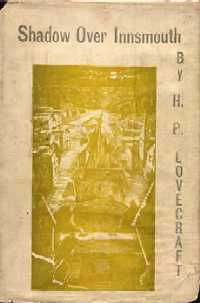
The Shadow over Innsmouth is a horror novella by American author H. P. Lovecraft, written in November–December 1931. It forms part of the Cthulhu Mythos, using its motif of a malign undersea civilization, and references several shared elements of the Mythos, including place-names, mythical creatures, and invocations. The Shadow over Innsmouth is the only Lovecraft story that was published in book form during his lifetime.

"The Nameless City" is a short horror story written by American writer H. P. Lovecraft in January 1921 and first published in the November 1921 issue of the amateur press journal The Wolverine. It is often considered the first story set in the Cthulhu Mythos world. In the story, the protagonist travels to the middle of the Arabian Desert to explore an ancient underground city.

"Pickman's Model" is a short story by H. P. Lovecraft, written in September 1926 and first published in the October 1927 issue of Weird Tales.

"The Outsider" is a short story by American horror writer H. P. Lovecraft. Written between March and August 1921, it was first published in Weird Tales, April 1926. In this work, a mysterious individual who has been living alone in a castle for as long as he can remember decides to break free in search of human contact and light. "The Outsider" is one of Lovecraft's most commonly reprinted works and is also one of the most popular stories ever to be published in Weird Tales.

"Dagon" is a short story by American author H. P. Lovecraft. It was written in July 1917 and is one of the first stories that Lovecraft wrote as an adult. It was first published in the November 1919 edition of The Vagrant. Dagon was later published in Weird Tales in October 1923. It is considered by many to be one of Lovecraft's most forward-looking stories.

"From Beyond" is a horror genre short story by American writer H. P. Lovecraft. It was written in 1920 and was first published in The Fantasy Fan in June 1934.
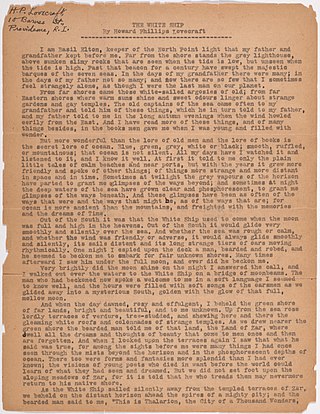
"The White Ship" is a horror short story by American writer H. P. Lovecraft. It was first published in The United Amateur #2, November 1919, and later appeared in the March 1927 issue of Weird Tales.
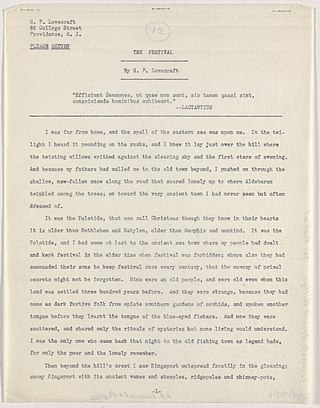
"The Festival" is a short story by H. P. Lovecraft written in October 1923 and published in the January 1925 issue of Weird Tales.

The Deep Ones are creatures in the Cthulhu Mythos of H. P. Lovecraft. The beings first appeared in Lovecraft's novella The Shadow over Innsmouth (1931), but were already hinted at in the early short story "Dagon". The Deep Ones are a race of intelligent ocean-dwelling creatures, approximately human-shaped but with a fishy appearance. The males would regularly mate with involuntary human females along the coast, creating societies of hybrids.

The Whisperer in Darkness is a 26,000-word novella by American writer H. P. Lovecraft. Written February–September 1930, it was first published in Weird Tales, August 1931. Similar to The Colour Out of Space (1927), it is a blend of horror and science fiction. Although it makes numerous references to the Cthulhu Mythos, the story is not a central part of the mythos, but reflects a shift in Lovecraft's writing at this time towards science fiction. The story also introduces the Mi-Go, an extraterrestrial race of fungoid creatures.

"The Rats in the Walls" is a short story by American author H. P. Lovecraft. Written in August–September 1923, it was first published in Weird Tales, March 1924.

"Hypnos" is a short story by American horror fiction writer H. P. Lovecraft, penned in March 1922 and first published in the May 1923 issue of National Amateur.
"The Picture in the House" is a short story written by H. P. Lovecraft. It was written on December 12, 1920, and first published in the July issue of The National Amateur—which was published in the summer of 1921. It was reprinted in Weird Tales in 1923 and again in 1937.
"The Temple" is a short story written by H. P. Lovecraft in 1920, and first published in the pulp magazine Weird Tales #24 in September 1925.
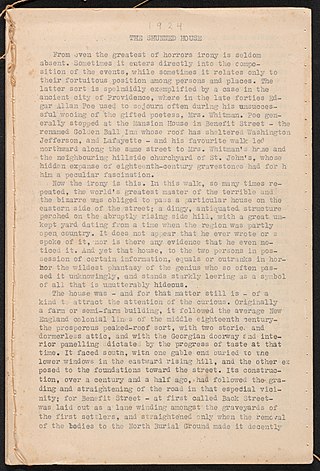
"The Shunned House" is a horror fiction novelette by American author H. P. Lovecraft, written on October 16–19, 1924. It was first published in the October 1937 issue of Weird Tales.

"He" is a short story by American horror writer H. P. Lovecraft. Written August 1925, it was first published in Weird Tales, September 1926.
"The Evil Clergyman" is an excerpt from a letter written by American horror fiction writer H. P. Lovecraft in 1933. After his death, it was published in the April 1939 issue of Weird Tales as a short story. The story was later adapted into the unreleased 1987 anthology film Pulse Pounders.

"Herbert West–Reanimator" is a horror short story by American writer H. P. Lovecraft. It was written between October 1921 and June 1922. It was first serialized in February through July 1922 in the amateur publication Home Brew. The story was the basis of the 1985 horror film Re-Animator and its sequels, in addition to numerous other adaptations in various media.

"Medusa's Coil" is a short story by H. P. Lovecraft and Zealia Bishop. It was first published in Weird Tales magazine in January 1939, two years after Lovecraft's death. The story concerns the son of an American plantation owner who brings back from Paris a new wife. It mixes elements of Lovecraft's Cthulhu Mythos with the ancient Greek myth of Medusa, but it has also been noted for its racist aspects.
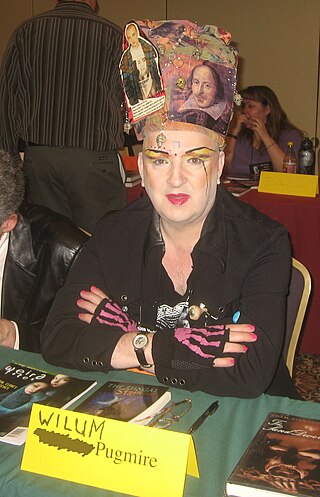
Wilum Hopfrog Pugmire, was a writer of weird fiction and horror fiction based in Seattle, Washington. His works typically were published as W. H. Pugmire and his fiction often paid homage to the lore of Lovecraftian horror. Lovecraft scholar and biographer S. T. Joshi described Pugmire as "the prose-poet of the horror/fantasy field; he may be the best prose-poet we have" and as one of the genre's leading Lovecraftian authors.

















